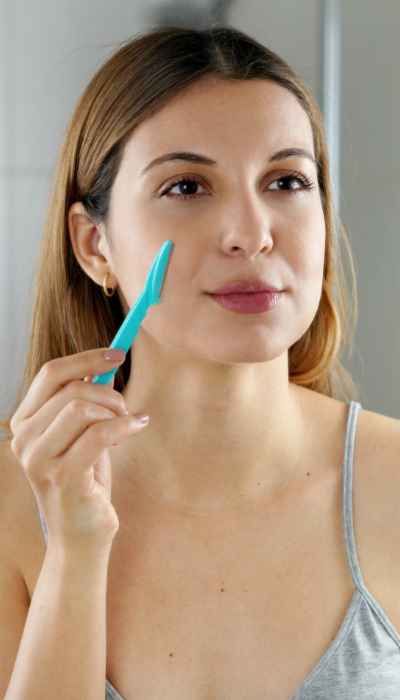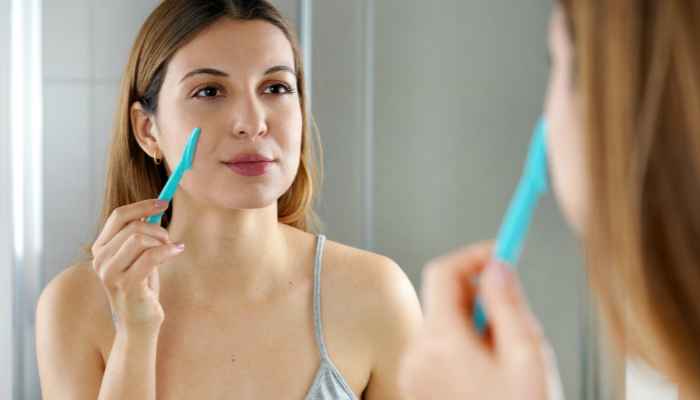Last Updated on April 26, 2024 by Ryan
Dermaplaning has been around for some time now. However, it has recently become a popular topic, especially among those hoping to look more beautiful. To those who have tried dermaplaning in the past or are just knowledgeable about the subject, it even appears to be the secret to having a smooth face like a celebrity’s.
There are also those critical of dermaplaning because the procedure can supposedly leave your face with thicker hair or even discolored. But what is the truth? Does it do more harm than good? Is it just another rejuvenating procedure that a lot of people are talking about? Or is it the secret to having a smooth and glowing face?
What Is Dermaplaning?
Dermaplaning is the procedure by which a sharp tool is used to gently remove the tiny and fine hairs that surround your face. The device used for the procedure is usually a surgical scalpel, which curves to a sharp point and measures about 10 inches in length. It is most often used on dry cheeks, the forehead, the neck, and the nose.
For the majority of the procedure, a dermatologist or esthetician uses this tool to gently scrape the surface of your skin with very gentle and light strokes.
Although it might sound painful, it usually isn’t. For example, if the procedure is conducted at a reputable local business, such as Candid Cosmedics, that specializes in dermaplaning, one most often walks away without any recurring pains and scratches. While some people experience a slight irritation or reddening of the face post-procedure, it is generally harmless.
Now that you know about dermaplaning’s potential side effects, here are the benefits you can enjoy after undergoing this procedure.
Immediate Results
According to many skin specialists, the reduction of facial hair and dead skin cells will brighten up your face after your first treatment. Yes, there should probably be multiple treatments if you want to enjoy the benefits of having a more youthful face long-term. Take note that our skin’s top layer is continuously exposed to irritants, toxins, oil, and dirt, especially if you are riding public transport.
Due to the process of constantly going out of the house, smoke, dirt, and other foreign materials come in contact with your skin, making it dirtier. However, with dermaplaning, your dermatologist can scrape off all the dirt and dead skin cells to reveal more vibrant and youthful skin just hiding underneath.
Rejuvenated Skin
As a consequence of dermaplaning, getting rid of those dead skin cells helps spur the development of healthier skin cells. This in turn rejuvenates your facial skin and evens your skin tone. If you suffer from dark spots or discoloration on your skin, it will also help to reduce that as well.
Overall, the procedure will make your skin brighter and fresher by smoothing out rough spots on your face and brightening your complexion.
Safe For the Very Sensitive
If you have ultra-sensitive skin, especially after one session of dermabrasion, dermaplaning might be the better option for you. Yes, dermaplaning uses a sharp tool to scrape all the dead skin cells and little hairs, but it is painless, making it an excellent option for those with sensitive skin.
If you’re pregnant and afraid of having a plethora of chemicals being introduced to your body, dermaplaning should be considered an option. The results are immediate, and the procedure is completely safe for both you and your baby.
Peach Fuzz Removal
Do you have peach fuzz and have been bothered by it for a while now? Dermaplaning is again an excellent solution to your problems. Besides facial rejuvenation, dermaplaning is also known for removing that invisible hair. The peach fuzz is practically invisible, but, once removed, you will notice the effect almost immediately, especially if you are applying makeup.
Many patients also say that their chin is smoother and softer to the touch after the procedure. One of the known advantages of dermaplaning is that it’s a great option to have when you want to remove the dark hair around your face. It’s also useful for removing the fine vellus hairs that can’t be seen unless looked upon closely.
Makeup Looks Better
The days following the procedure are an excellent time to apply makeup to your face. Once you’ve done so, you will notice that your makeup looks better after the procedure because your face absorbs the pigments more.
This is because the dead skin cells are removed. Thus, your face will absorb more pigments, making the colors brighter. Your foundation and powder will also be a lot smoother because there will be no more hairs to make creases on them.
Side Effects of Dermaplaning
Dermaplaning is safe and applies to all skin types. As a result, side effects are rare. Those who are ultra-sensitive may have skin reddening for a few hours after the procedure, but it will eventually be gone while still retaining the procedure’s effects. However, those who have skin issues like active acne, wounds, or nickel allergy or have recently used Accutane within six months are advised not to undergo the procedure.
After the procedure, you should not expose your face to direct sunlight or wear sunscreen because it will worsen the reddening of your skin (especially true if you experience skin reddening but just generally avoid these). You should also avoid applying exfoliants and retinol for at least 48 hours after the procedure. However, you can apply makeup directly after the procedure.
Takeaway
Although there are many things you should look forward to about this procedure, you should carefully consider it before undergoing it. Experts advise not to undergo dermaplaning if you have active acne, excessively oily skin, or excessive facial hair growth. Moreover, results will vary depending on the type of skin you have. Overall, dermaplaning is safe, and there is good reason to try it out.
Is dermaplaning good for your skin?
Dermaplaning helps reduce the visibility of wrinkles, fine lines, and dull skin. Smoother, firmer, and healthier skin may be revealed after the operation.
Is dermaplaning just shaving?
Dermaplaning, sometimes known as “shaving your face,” is a procedure that includes delicately pulling a blade across your skin. But! In contrast to regular shaving, dermaplaning employs a tiny blade to remove dead skin cells and thin facial hair, resulting in skin that is more uniform in tone and texture.
Does hair grow back thicker after dermaplaning?
Let’s start off by just saying “NO” to clear the air. It’s a fallacy that following dermaplaning, your facial hair will get darker or thicker. Your hair simply cannot perform this task because dermaplaning is a non-invasive exfoliation procedure. Although the hair will regrow, neither its color nor thickness will alter.

